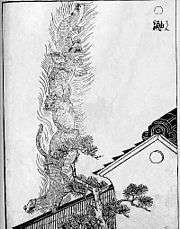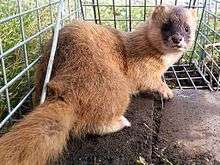Weasel
| Weasel | |
|---|---|
 | |
| Least weasel | |
| Scientific classification | |
| Kingdom: | Animalia |
| Phylum: | Chordata |
| Class: | Mammalia |
| Order: | Carnivora |
| Suborder: | Caniformia |
| Family: | Mustelidae |
| Subfamily: | Mustelinae |
| Genus: | Mustela Linnaeus, 1758 |
| Type species | |
| Mustela erminea Linnaeus, 1758 | |
| Species | |
 | |
A weasel /ˈwiːzəl/ is a mammal of the genus Mustela of the family Mustelidae. The genus Mustela includes the least weasels, polecats, stoats, ferrets, and minks. Members of this genus are small, active predators, with long and slender bodies and short legs. The family Mustelidae (which also includes badgers, otters, and wolverines) is often referred to as the "weasel family". In the UK, the term "weasel" usually refers to the smallest species Mustela nivalis.[1]
Weasels vary in length from 173 to 217 mm (6.8 to 8.5 in),[2] females being smaller than the males, and usually have red or brown upper coats and white bellies; some populations of some species moult to a wholly white coat in winter. They have long, slender bodies, which enable them to follow their prey into burrows. Their tails may be from 34 to 52 mm (1.3 to 2.0 in) long.[2]
Weasels feed on small mammals, and have from time to time been considered vermin, since some species took poultry from farms, or rabbits from commercial warrens. They do on the other hand eat large numbers of rodents. They can be found all across the world except for Antarctica, Australia, and neighbouring islands.
Terminology
The English word "weasel" was originally applied to one species of the genus, the European form of the least weasel (Mustela nivalis). This usage is retained in British English, where the name is also extended to cover several other small species of the genus. However, in technical discourse and in American usage, the term "weasel" can refer to any member of the genus, or to the genus as a whole. Of the 17 extant species currently classified in the genus Mustela, 10 have "weasel" in their common names. Among those that do not are the stoat, the polecats, the ferret, and the European mink. The American mink and the extinct sea mink were commonly included in this genus as Mustela vison and Mustela macrodon respectively, but in 1999 were moved to the genus Neovison.[3]
Species
The following information is according to the Integrated Taxonomic Information System.
| Mustela africana | Desmarest, 1800 | Amazon weasel | South America |
| Mustela altaica | Pallas, 1811 | Mountain weasel | Europe & Northern Asia Southern Asia |
| Mustela erminea | Linnaeus, 1758 | Stoat Ermine Short-tailed weasel | Europe & Northern Asia North America Southern Asia (non-native) New Zealand (non-native) |
| Mustela eversmannii | Lesson, 1827 | Steppe polecat | Europe & Northern Asia Southern Asia |
| Mustela felipei | Izor and de la Torre, 1978 | Colombian weasel | South America |
| Mustela frenata | Lichtenstein, 1831 | Long-tailed weasel | Middle America North America South America |
| Mustela itatsi | Temminck, 1844 | Japanese weasel | Japan & Sakhalin Is. (Russia) |
| Mustela kathiah | Hodgson, 1835 | Yellow-bellied weasel | Southern Asia |
| Mustela lutreola | (Linnaeus, 1761) | European mink | Europe |
| Mustela lutreolina | Robinson and Thomas, 1917 | Indonesian mountain weasel | Southern Asia |
| Mustela nigripes | (Audubon and Bachman, 1851) | Black-footed ferret | North America |
| Mustela nivalis | Linnaeus, 1766 | Least weasel | Europe, Northern Asia North America Southern Asia (non-native) New Zealand (non-native) |
| Mustela nudipes | Desmarest, 1822 | Malayan weasel | Southern Asia |
| Mustela putorius | Linnaeus, 1758 | European polecat Domesticated ferret (ssp. furo) | Europe, northern Asia New Zealand (ssp. furo) (non-native) |
| Mustela sibirica | Pallas, 1773 | Siberian weasel | Europe, northern Asia Southern Asia |
| Mustela strigidorsa | Gray, 1855 | Back-striped weasel | Southern Asia |
| Mustela subpalmata | Hemprich & Ehrenberg, 1833 | Egyptian weasel | northern Egypt |
1 Europe and northern Asia division excludes China.
Hybrids in this genus include the polecat-ferret hybrid and the polecat-mink hybrid.
Cultural meanings
Weasels have been assigned a variety of cultural meanings.
In Greek culture, a weasel near one's house is a sign of bad luck, even evil, "especially if there is in the household a girl about to be married", since the animal (based on its Greek etymology) was thought to be an unhappy bride who was transformed into a weasel[4] and consequently delights in destroying wedding dresses.[5] In neighboring Macedonia, however, weasels are generally seen as an omen of good fortune.[4][5]
In early modern Mecklenburg, Germany, amulets from weasels were deemed to have strong magic; the period between August 15 and September 8 was specifically designated for the killing of weasels.
In Montagne Noire (France), Ruthenia, and the early medieval culture of the Wends, weasels were not meant to be killed.[6]
In North America, Native Americans deemed the weasel to be a bad sign; crossing its path meant a "speedy death".[7] According to Daniel Defoe also, meeting a weasel is a bad omen.[8] In English-speaking areas, weasel can be a disparaging term, noun or verb, for someone regarded as sneaky, conniving or untrustworthy. Similarly, weasel words is a critical term for words or phrasing that are vague, misleading or equivocal.
Japanese folklore


In Japan, weasels (鼬、鼬鼠 itachi) were seen as yōkai from time immemorial, and they cause various strange occurrences. According to the encyclopedia Wakan Sansai Zue from the Edo period, a nate of weasels would cause conflagrations, and the cry of a weasel was considered a harbinger of misfortune. In the Niigata Prefecture, the sound of a nate of weasels making a rustle resembled six people hulling rice, so was called the "weasel's six-person mortar", and it was an omen for one's home to decline or flourish. It is said that when people chase after this sound, the sound stops.[9]
They are also said to shapeshift like the fox (kitsune) or tanuki, and the nyūdō-bōzu told about in legends in the Tōhoku region and the Chūbu region are considered weasels in disguise, and they are also said to shapeshift into ōnyūdō and little monks.[9]
In the collection of depictions, the Gazu Hyakki Yagyō by Sekien Toriyama, they were depicted under the title 鼬, but they were read not as "itachi", but rather as "ten",[10] and "ten" were considered to be weasels that have reached one hundred years of age and became yōkai that possessed supernatural powers.[11] Another theory is that when weasels reach several hundred years of age, they become mujina (badger).[12]
In Japanese weasels are called iizuna or izuna (飯綱) and in the Tōhoku Region and Shinshu, it was believed that there were families that were able to use a certain practice to freely use kudagitsune as iizuna-tsukai or kitsune-mochi. It is said that Mount Iizuna, from the Nagano Prefecture, got its name due to how the gods gave people mastery of this technique from there.[13]
According to the folkloristician Mutō Tetsujō, "They are called izuna in the Senboku District,[* 1] Akita Prefecture, and there are also the ichiko (itako) that use them."[14] Also, in the Kitaakita District, they are called mōsuke (猛助), and they are feared as yōkai even more than foxes (kitsune).[14]
In the Ainu language, ermines are called upas-čironnup or sáčiri, but since least weasels are also called sáčiri, Mashio Chiri surmised that the honorary title poy-sáčiri-kamuy (where poy means "small") refers to least weasels.[15]
Kamaitachi
Kamaitachi are a phenomenon wherein one who is idle is suddenly injured, as if his or her skin were cut by a scythe. In the past, this was thought to be "the deed of an invisible yōkai weasel". However, this has been established as a physiological phenomenon that dried skin that receives a shock would tear off. An alternate theory, asserts that kamaitachi are derived from kamae tachi (構え太刀 "stance sword"), so were not originally related to weasels at all.
In popular culture
Film
- In the Foghorn Leghorn animated film Plop Goes the Weasel (1953), a weasel tries to capture Foghorn Leghorn for food.
- In Who Framed Roger Rabbit (1988), Judge Doom's Toon Patrol were five weasels.
Literature
- In Kenneth Grahame's classic children's book, The Wind in the Willows (1908), a pack of armed weasels, accompanied by other Mustelids, overruns Toad Hall and has to be driven out by Badger, Mole, Ratty, and Toad.
- In Phil Drabble's book A Weasel in my Meatsafe (1979), it is suggested that a weasel can make an endearing pet.
Notes
References
- ↑ Shorter Oxford English dictionary. United Kingdom: Oxford University Press. 2007. p. 3804. ISBN 0199206872.
- 1 2 "The Weasel". The Mammal Society. Retrieved 18 January 2013.
- ↑ Abramov, A.V. 1999. A taxonomic review of the genus Mustela (Mammalia, Carnivora). Zoosystematica Rossica, 8(2): 357-364
- 1 2 Lawson, John Cuthbert (2012). Modern Greek Folklore and Ancient Greek Religion: A Study in Survivals. Cambridge UP. pp. 327–28. ISBN 978-1-107-67703-6. Retrieved 13 February 2012.
- 1 2 Abbott, George Frederick (1903). Macedonian folklore. Cambridge UP. pp. 108–109. Retrieved 13 February 2012.
- ↑ Thomas, N.W. (September 1900). "Animal Supterstitions and Totemism". Folk-lore. 11: 228–67.
- ↑ Brown, Frank C.; Hand, Wayland D. (1977). Frank C. Brown Collection of North Carolina Folklore: Popular Beliefs and Superstitions from North Carolina. Duke UP. p. 56. ISBN 978-0-8223-0259-9. Retrieved 13 February 2012.
- ↑ Hazlitt, William Carew; Brand, John (1905). Faiths and folklore: a dictionary of national beliefs, superstitions and popular customs, past and current, with their classical and foreign analogues, described and illustrated. Reeves and Turner. p. 622. Retrieved 13 February 2012.
- 1 2 村上健司編著 『妖怪事典』 毎日新聞社、2000年、36頁。ISBN 978-4-6203-1428-0。
- ↑ 高田衛監修 稲田篤信・田中直日編 『鳥山石燕 画図百鬼夜行』 国書刊行会、1992年、50頁。ISBN 978-4-336-03386-4。
- ↑ 少年社・中村友紀夫・武田えり子編 『妖怪の本 異界の闇に蠢く百鬼夜行の伝説』 学習研究社〈New sight mook〉、1999年、123頁。ISBN 978-4-05-602048-9。
- ↑ 草野巧 『幻想動物事典』 新紀元社、1997年、30頁。ISBN 978-4-88317-283-2。
- ↑ 『広辞苑 第4版』(1991年)、岩波書店「いづなつかい【飯綱使・飯縄遣】」の項
- 1 2 3 武藤, 鉄城 (1940), "秋田郡邑魚譚", アチックミユーゼアム彙報, 「仙北地方/生保内村」の部, 45: 41–42,
北秋田ではモウスケと称して狐より怖がられ、仙北地方ではイヅナと称し、それを使う巫女(エチコ)もある。学名コエゾイタチを、此の付近..〔生保内村〕では..オコジョと云ふ(田口耕之助氏)
。 - ↑ 知里, 真志保 (Chiri, Mashiho) (30 Mar 1959), "アイヌ語獣名集 (On the names of the mammals of the Ainu language)" (pdf), 北海道大學文學部紀要 = The annual reports on cultural science: 141, ISSN 0437-6668
Further reading
- "Mustela". Integrated Taxonomic Information System. Retrieved 24 July 2007.
- Nowak, Ronald M., and Ernest P. Walker. Walker's Carnivores of the World. Baltimore: Johns Hopkins University Press, 2005. ISBN 0-8018-8033-5, ISBN 0-8018-8032-7.
- C. Hart Merriam, Synopsis of the Weasels of North America, Washington, Government Printing Office, 1896.
- Angier, Natalie (June 13, 2016). "Weasels Are Built for the Hunt". The New York Times. Retrieved June 15, 2016.
External links
-
 The dictionary definition of weasel at Wiktionary
The dictionary definition of weasel at Wiktionary -
 Media related to Mustela at Wikimedia Commons
Media related to Mustela at Wikimedia Commons -
 Data related to Mustela at Wikispecies
Data related to Mustela at Wikispecies